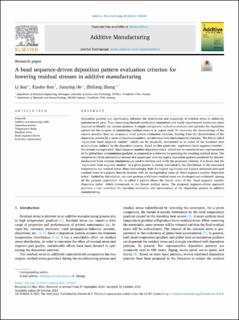| dc.contributor.author | Sun, Li | |
| dc.contributor.author | Ren, Xiaobo | |
| dc.contributor.author | He, Jianying | |
| dc.contributor.author | Zhang, Zhiliang | |
| dc.date.accessioned | 2022-09-19T09:59:40Z | |
| dc.date.available | 2022-09-19T09:59:40Z | |
| dc.date.created | 2021-10-27T14:45:15Z | |
| dc.date.issued | 2021 | |
| dc.identifier.issn | 2214-8604 | |
| dc.identifier.uri | https://hdl.handle.net/11250/3018830 | |
| dc.description.abstract | Deposition patterns can significantly influence the distribution and magnitude of residual stress in additively manufactured parts. Time-consuming thermal-mechanical simulations and costly experimental studies are often required to identify the optimal patterns. A simple and generic method to evaluate and optimize the deposition pattern for the purpose of minimizing residual stress is in urgent need. To overcome the shortcomings of the current practice, here we propose a novel pattern evaluation criterion. Starting from the discretization of the deposition pattern by a series of sequence numbers, we introduce two interconnected concepts. The first is called “equivalent bead sequence number” which can be physically interpreted as an index of the localized heat accumulation induced by the deposition process. Based on this point-wise “equivalent bead sequence number”, the second concept called “bead sequence number dispersion index” which can be considered as a representation of the global heat accumulation gradient, is proposed as a criterion for assessing the resulting residual stress. The temperature fields and residual stresses of a square part with six typical deposition patterns predicted by thermo-mechanical finite element simulations are used to develop and verify the proposed criterion. It is found that the “equivalent bead sequence number” of a given pattern is closely correlated to the distribution of the associated temperature and residual stress. More interestingly, both the highest equivalent and highest maximum principal residual stress of a pattern linearly increase with its corresponding value of “bead sequence number dispersion index”. Guided by this relation, two new patterns with lower residual stress are developed and evaluated. Among all the patterns considered, the so-called S pattern shows the lowest value of the “bead sequence number dispersion index” which corresponds to the lowest residual stress. The proposed sequence-driven approach provides a new candidate for real-time evaluation and optimization of the deposition pattern in additive manufacturing. | en_US |
| dc.language.iso | eng | en_US |
| dc.publisher | Elsevier | en_US |
| dc.rights | Navngivelse 4.0 Internasjonal | * |
| dc.rights.uri | http://creativecommons.org/licenses/by/4.0/deed.no | * |
| dc.title | A bead sequence-driven deposition pattern evaluation criterion for lowering residual stresses in additive manufacturing | en_US |
| dc.type | Peer reviewed | en_US |
| dc.type | Journal article | en_US |
| dc.description.version | publishedVersion | en_US |
| dc.rights.holder | © 2021 The Author(s). Published by Elsevier B.V | en_US |
| dc.source.pagenumber | 14 | en_US |
| dc.source.volume | 48 | en_US |
| dc.source.journal | Additive Manufacturing | en_US |
| dc.identifier.doi | 10.1016/j.addma.2021.102424 | |
| dc.identifier.cristin | 1948951 | |
| dc.relation.project | Norges forskningsråd: 281927 | en_US |
| dc.relation.project | Norges forskningsråd: 269558 | en_US |
| dc.source.articlenumber | 102424 | en_US |
| cristin.ispublished | true | |
| cristin.fulltext | postprint | |
| cristin.qualitycode | 1 | |

